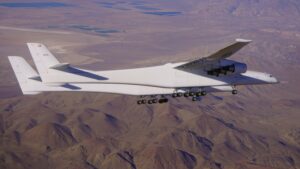The aircraft, nicknamed Roc, took off from the Mojave Air and Space Port in California at 10:28 a.m. Eastern, landing back at the airport three hours and 14 minutes later. The plane achieved a maximum altitude of nearly 4,300 meters and top speed of 320 kilometers per hours during the flight.
“Today’s flight was very successful. We accomplished all of our test objectives,” Zachary Krevor, chief operating officer of Stratolaunch, said in a call with reporters after the flight. “We have not seen anything anomalous, and we are very pleased with the condition of the aircraft upon landing.”
The flight was the first since the plane’s inaugural flight in April 2019, also in Mojave. Since then, the company, established by the late Microsoft co-founder Paul Allen, was sold to a private equity group, Cerebus. Under that new ownership, Stratolaunch has shifted direction from being a launch services provider, using the plane as a platform for an air-launch system, to using it to support hypersonic testing using a vehicle it is developing called Talon-A.
The company also used the time to upgrade the aircraft. Those changes, Krevor said, include a new environmental control system, additional instruments and “increasing the robustness” of the plane’s flight control system intended to improve its handling qualities.
This flight marks the beginning of a flight test campaign expected to continue through the next year. “Over the next year, the airplane will go higher, it will go faster, until we are in the envelope that’s required to drop our Talon testbed so it can achieve hypersonic flight,” said Daniel Millman, chief technical officer of Stratolaunch.
Krevor said that test campaign will include a “range of flights” with increasing complexity, but declined to say how many flights were planned. “The exact number of flights will be dependent on how we are able to complete the test objectives of each flight,” he said.
In parallel to that flight test program, Stratolaunch is working on prototypes of its Talon-A hypersonic vehicle. That includes a “separation test article” that will be flown on the aircraft early next year and dropped to test the safe separation of Talon from the plane.
That will be followed by the first powered Talon test vehicle. “Early next year we’re going to go hypersonic with an expendable vehicle to expand the envelope,” Millman said. That will be followed by reusable vehicles that will land on a runway and can be reflown up to 25 times.
Millman said Stratolaunch is currently testing Hadley, a 5,000-pounds-force engine from Ursa Major Technologies, for use on Talon-A. “We’ll be running it on a test stand, making sure the propulsion and integration is what we expect it to be before we start putting it on the vehicle,” he said.
Stratolaunch is looking to offer its vehicle system to the Defense Department to test hypersonic technologies. “One of the areas that we’re looking at is how can we help the Department of Defense in mitigating risk for a lot of their expensive flight testing,” he said. “What we’re doing is providing a path for them to test a lot of their technologies in a simpler way, a repeatable way, a reusable way.”



